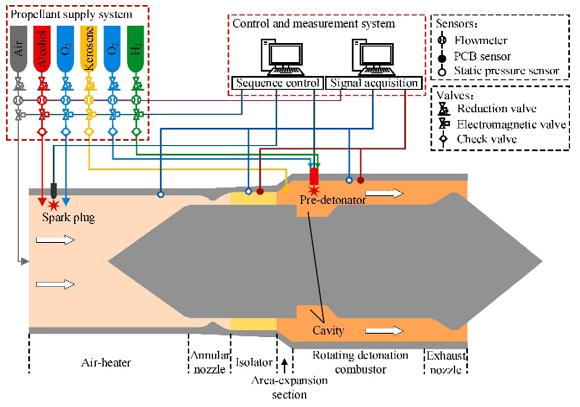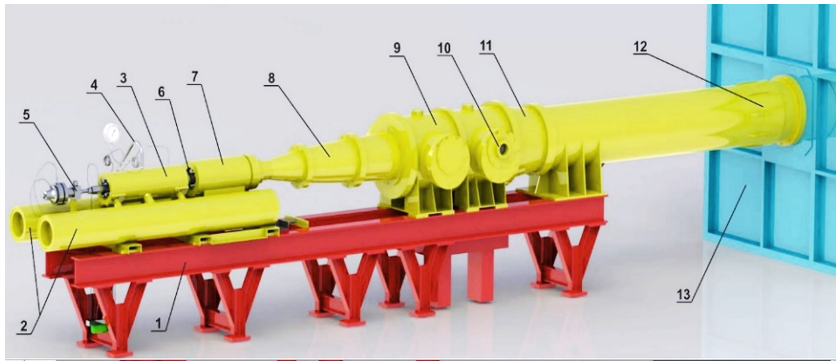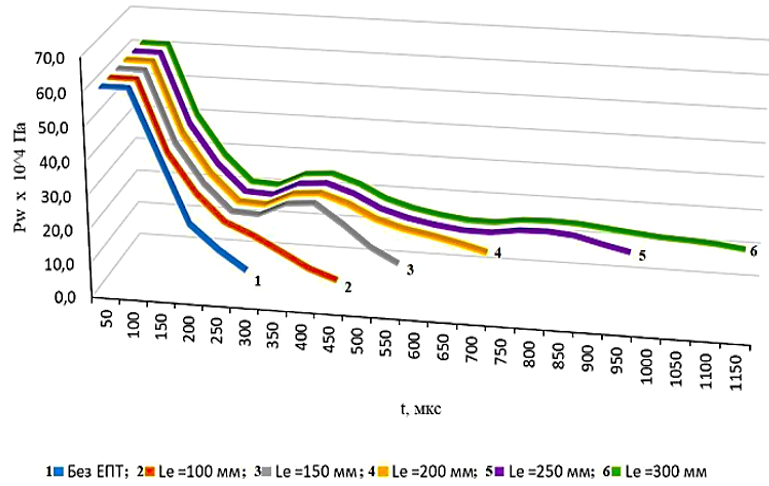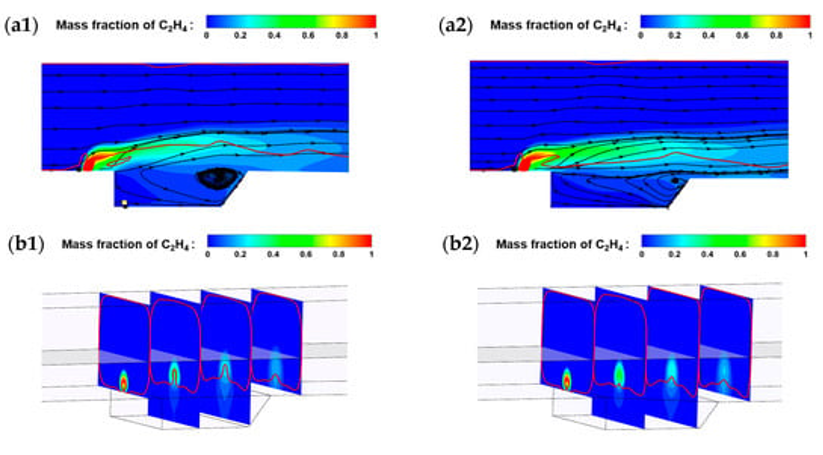Experimental Study of Methods of Increasing the Efficiency of a Direct-Flow Air-Jet Detonation Engine
Vitalii Stoliarchuk
Oles Dnipro National University, Dnipro,
Yuzhnoye State Design Office, Dnipro
Olexandr Zolotko
Oles Dnipro National University, Dnipro
Оlexandr Aksonov
Oles Dnipro National University, Dnipro,
Yuzhnoye State Design Office, Dnipro
Introduction
A fundamentally new direction in the development of rocket and space propulsion is the introduction of jet engines operating on the detonation principle of energy conversion of the working body. The use of detonation fuel combustion allows to increase the thermodynamic efficiency of the engine and the thermodynamic efficiency of fuel combustion. Detonation is a hydrodynamic wave process of propagation of an exothermic reaction zone in a substance at a supersonic speed. The detonation wave is the main shock wave, behind the front of which a chemical reaction is continuously initiated due to heating during adiabatic compression.
Engines in which the time of release of fuel energy in each volume is less than the time of the beginning of the decomposition of gasification products are called detonation engines. A feature of this process is a large pressure drop before the detonation wave and in the induction zone, where the reaction takes place. At such a rate of fuel energy release, the thermo-gas dynamic characteristics of the engine are improved, the prerequisites are created for simplifying the design of the combustion chamber, reducing the size, volume, and weight of the engine, improving thermodynamic efficiency, a significant gain in technical characteristics and a high degree of structural perfection of promising engine installations. The completeness of the combustion of fuel mixtures in the chambers during the detonation combustion mode can be significantly increased due to the occurrence of large pressure and velocity gradients. Along with this, the processes of mixing and evaporation change, the process of evaporation of drops of liquid fuel depends on the heat and mass exchange between the drops and hot gas. Detonation and acoustic oscillations cause additional convective movement of gas and contribute to the acceleration of transfer processes. The subject of research in the article is the modeling and study of the processes occurring in a direct-flow air-jet engine operating on the detonation principle of energy conversion of the working body. The problem of increasing the efficiency of jet detonation engines should be solved in the complex of structural synthesis using the accumulated knowledge on jet engines with deflagration fuel combustion.
The aim and tasks of the study
The subject of the study is the modeling of processes occurring in a direct-current jet engine with detonation conversion of the chemical energy of the working body into the kinetic energy of the jet. The purpose of the work is to obtain the results of studies of the defining characteristics: the development of mathematical models of the kinetics of gas-dynamic and thermal processes in the detonation combustion chamber with an aerodynamic valve and taking into account the composition and properties of the gas in the working environment of the chamber; modeling of work processes that take place in the flow part of the engine; study of the mechanism of self-oscillations in the chamber based on kinematic patterns of gas movement; development of methods of experimental measurements of detonation flows for verification of calculation models; refinement of the engineering methodology for calculating detonation combustion chambers with an aerodynamic valve of a direct-flow air-jet engine for a given thermal power [1].
Materials and methods
The subject of the study is the modeling of processes that occur in a direct-flow jet engine with detonation conversion of the chemical energy of the working body into the kinetic energy of the jet. The purpose of the work is to obtain the results of research of gas-dynamic and thermal processes in a direct-flow air-jet detonation chamber with an aerodynamic valve. One of the tools for solving such a problem is the method of a numerical experiment using mathematical modeling technologies. At an extremely high rate of energy release from the detonation combustion of fuel components, the traction and impulse characteristics of the engine are significantly increased, the prerequisites are created for simplifying its design, reducing dimensions and mass, which allows to achieve structural perfection of detonation engine installations. The purpose of the work is to obtain the results of studies of the defining characteristics: the development of mathematical models of the kinetics of gas-dynamic and thermal processes in the detonation combustion chamber with an aerodynamic valve and taking into account the composition and properties of the gas in the working environment of the chamber [2, 3, 5], modeling of work processes that take place in the flow part of the engine; study of the mechanism of self-oscillations in the chamber based on kinematic patterns of gas movement, development of methods of experimental measurements of detonation flows for verification of calculation models [4, 6, 7], improvement of the engineering methodology for calculating detonation combustion chambers with an aerodynamic valve of a direct-flow air-jet engine for a given power.
Figure 1- Schematic diagram of the experimental system [9]
Figure 2- Experimental setup for determining the characteristics of a direct-flow air-jet detonation engine [1]
1 – frame; 2 – container for storing compressed air with heaters; 3 – the main fore-chamber; 4 – compressed air supply pipeline; 5 – remote quick-acting valve; 6 – connecting pipeline; 7 – auxiliary pre-chamber; 8 – replaceable part of the nozzle; 9 – the working part, where the direct-flow air-jet detonation engine is placed; 10 – the optical window for visualizing the process; 11 – confusor; 12 – exhaust diffuser; 13 – sound absorption chamber.
Results
Based on the results of theoretical and experimental studies, an engineering method of chamber calculation is proposed, mathematical models of gas-dynamic and thermal processes in a detonation combustion chamber with an aerodynamic valve are proposed, taking into account the ratio of air and fuel consumption, allowing to determine the properties and composition of combustion products [3, 4, 7].
Figure 3 – Dependence of pressure change over time on the traction wall of the detonation chamber when using cylindrical ejector thrust amplifiers of different lengths: рw – pressure on the traction wall of the DC; t – time; Le is the length of the ejector [7]
Figure 4 – Structural diagram of the designed ram-RDE model [10]
Figure 5 – Visualization of fuel distribution for the case of a conventional cavity chamber (a1, b1) and a cavity chamber with a rear wall (a2, b2), with an equivalence factor of 0.2 [4]
Figure 6 – А -Velocity distribution in the calculation area, m/s; В – Pressure distribution in the calculation area, MPa [1]
Summary
Calculated equations were obtained for determining the frequency of oscillations in the detonation combustion chamber taking into account the aerodynamic valve, a method was developed for calculating the kinetics of gas dynamic and thermal processes in the detonation combustion chamber depending on the coefficient of excess air regulated by the aerodynamic valve. Experimental data are used to validate the two-dimensional model, which in turn provides a basis for evaluating the performance of the reduced one-dimensional model. It was determined that the higher the pressure in the controlled system, the greater the free volume, the faster the adjustment speed of the actuator, and the greater the adjustment of the gas flow. Comparing the changes in the position of the flame front under the conditions of different injection distances, it was determined that under the same injection scheme, but different cavity configurations, the position of the flame front has the same tendency as the change in the equivalence coefficients, where the limit of lean blowing in the chamber combustion, when the short-range injection condition reaches a near-purge state, this is because the ignition in the cavity is greater than the flame stabilization in the combustion chamber, which is related to the power of the igniter discharge and the flow field environment inside the cavity [1, 2, 3, 4, 5, 6 , 7, 8, 11]. The conducted experiments confirm the correctness of the important technical decisions made and confirm the increase in the efficiency of the thermodynamic cycle by 20-35% in comparison with existing analogues on deflagration combustion. Experimental studies of the characteristics of detonation engines are relevant and involve the creation of a specialized laboratory and fire test stands for the rapid introduction of the latest technologies in the rocket and space industry.
References
- Aksonov O. S., Zolotko O. E., Stolyarchuk V. V. Complex approach to solving the problem of reliable cooling of the detonation engine chamber. Journal of Rocket-Space Technology. 2023. Vol. 30, no. 4. P. 23–29. URL: https://doi.org/10.15421/452204 (date of access: 29.05.2023).
- Characteristic of rotating detonation wave in the H2/Air hollow chamber with Laval nozzle / H. Zhang et al. International journal of hydrogen energy. 2021. Vol. 46, no. 24. P. 13389–13401. URL: https://doi.org/10.1016/j.ijhydene.2021.01.143 (date of access: 29.05.2023).
- Chen Y., Wang S., Liu W. Data-Driven transition models for aeronautical flows with a high-order numerical method. Aerospace. 2022. Vol. 9, no. 10. P. 578. URL: https://doi.org/10.3390/aerospace9100578 (date of access: 29.05.2023).
- Curran D., Wheatley V., Smart M. High mach number operation of accelerator scramjet engine. Published by the american institute of aeronautics and astronautics. 2023. No. 2. URL: https://doi.org/10.2514/1.A35511.
- Effects of cavity length on operating characteristics of a ramjet rotating detonation engine fueled by liquid kerosene / W. Feng et al. Fuel. 2023. Vol. 332. P. 126129. URL: https://doi.org/10.1016/j.fuel.2022.126129 (date of access: 29.05.2023).
- Effects of chamber width on h2/air rotating detonations / H. Zhang et al. International journal of aerospace engineering. 2020. Vol. 2020. P. 1–14. URL: https://doi.org/10.1155/2020/8819667 (date of access: 29.05.2023).
- Ejector detonation engine on environmentally friendly fuel components / O. V. Sosnovska et al. Aerospace technic and technology. 2021. No. 4. P. 20–27. URL: https://doi.org/10.32620/aktt.2021.4.03 (date of access: 29.05.2023).
- Numerical investigation of mass flow rate effects on multiplicity of detonation waves within a H2/Air rotating detonation combustor / M. Salvadori et al. International journal of hydrogen energy. 2022. Vol. 47, no. 6. P. 4155–4170. URL: https://doi.org/10.1016/j.ijhydene.2021.10.270 (date of access: 29.05.2023).
- Schematic diagram of the experimental system. https://doi.org/10.1016/j.fuel.2022.126129. URL: https://ars.els-cdn.com/content/image/1-s2.0-S0016236122029532-gr1.jpg (date of access: 29.05.2023).
- Structural diagram of the designed ram-RDE model. https://doi.org/10.1016/j.fuel.2022.126129. URL: https://ars.els-cdn.com/content/image/1-s2.0-S0016236122029532-gr3.jpg (date of access: 29.05.2023).
- Tian S., Duan Y., Chen H. Numerical investigation on aerodynamic characteristics of an active jets-matrix serving as pitch control surface. Aerospace. 2022. Vol. 9, no. 10. P. 575. URL: https://doi.org/10.3390/aerospace9100575 (date of access: 29.05.2023).







